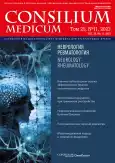Advices for diagnostics of ankylosing spondylitis/axial spondyloarthritis: A review
- Authors: Bunchuk N.V.1, Levshakova A.V.2
-
Affiliations:
- „Klinika Sesil'+“ LLC
- Hertsen Moscow Oncology Research Institute – branch of the National Medical Research Radiological Centre
- Issue: Vol 25, No 11 (2023): Neurology and rheumatology
- Pages: 755-765
- Section: Articles
- URL: https://journals.rcsi.science/2075-1753/article/view/253989
- DOI: https://doi.org/10.26442/20751753.2023.11.202461
- ID: 253989
Cite item
Full Text
Abstract
The article written by a rheumatologist and a radiologist who have long-term experience in diagnostics of ankylosing spondylitis (axial spondylitis), provides advices on rational recognition of these diseases. The first part of the article discusses adequate visualization of the sacroiliac joints and the need for thoughtful consideration of radiological and MRI signs of sacroiliitis, neither of which, taken alone, is pathognomonic. An optimal, from the authors' point of view, algorithm for conducting visualization studies of sacroilial joints is proposed. Numerous situations simulating sacroiliitis are analyzed.
Full Text
##article.viewOnOriginalSite##About the authors
Nikolay V. Bunchuk
„Klinika Sesil'+“ LLC
Author for correspondence.
Email: nbunchuk@yahoo.com
ORCID iD: 0000-0002-4728-400X
D. Sci. (Med.), „Klinika Sesil'+“ LLC
Russian Federation, MoscowAntonina V. Levshakova
Hertsen Moscow Oncology Research Institute – branch of the National Medical Research Radiological Centre
Email: nbunchuk@yahoo.com
ORCID iD: 0000-0002-2381-4213
D. Sci. (Med.), Hertsen Moscow Oncology Research Institute – branch of the National Medical Research Radiological Centre
Russian Federation, MoscowReferences
- Rudwaleit M, Jurik AG, Hermann KG, et al. Defining active sacroiliitis on magnetic resonance imaging (MRI) for classification of axial spondyloarthritis: a consensual approach by the ASAS/OMERACT MRI group. Ann Rheum Dis. 2009;68(10):1520-7. doi: 10.1136/ard.2009.110767
- Calin A. Ankylosing spondylitis sine sacroiliitis. Arthritis Rheum. 1979;22(3):303-4. doi: 10.1002/art.1780220316
- Khan MA, van der Linden SM, Kushner I, et al. Spondylitic disease without radiologic evidence of sacroiliitis in relatives of HLA-B27 positive ankylosing spondylitis patients. Arthritis Rheum. 1985;28(1):40-3. doi: 10.1002/art.1780280107
- Heuft-Dorenbosch L, Landewé R, Weijers R et al. Combining information obtained from magnetic resonance imaging and conventional radiographs to detect sacroiliitis in patients with recent onset inflammatory back pain. Ann Rheum Dis. 2006;65(6):804-8. doi: 10.1136/ard.2005.044206
- Dihlmann W. Current radiodiagnostic concept of ankylosing spondylitis. Skeletal Radiol. 1979;4(4):179-88. doi: 10.1007/BF00347211
- Poddubnyy D, Weineck H, Diekhoff T, et al. Clinical and imaging characteristics of osteitis condensans ilii as compared with axial spondyloarthritis. Rheumatology (Oxford). 2020;59(12):3798-806. doi: 10.1093/rheumatology/keaa175
- Dixon AS, Lience E. Sacro-iliac joint in adult rheumatoid arthritis and psoriatic arthropathy. Ann Rheum Dis. 1961;20(3):247-57. doi: 10.1136/ard.20.3.247
- Kreutzinger V, Diekhoff T, Liefeldt L, et al. Asymptomatic secondary hyperparathyroidism can mimic sacroiliitis on computed tomography. Sci Rep. 2021;11(1):4323. doi: 10.1038/s41598-021-83989-1
- Vogler JB 3rd, Brown WH, Helms C, Genant HK. The normal sacroiliac joint: a CT study of asymptomatic patients. Radiology. 1984;151(2):433-7. doi: 10.1148/radiology.151.2.6709915
- Forestier J. The importance of sacroiliac changes in the early diagnosis of ankylosing spondylarthritis. Marie–Strumpell–Bechterew disease. Radiology. 1939;33(3):389-402. doi: 10.1148/33.3.389
- Lindvall N. In: Proceedings from a symposium on Bechterew’s syndrome and allied disorders. Oslo, Norway, October 22–24, 1979. Scand J Rheumatol Suppl. 1980;32:1-252.
- Dale K. In: Proceedings from a symposium on Bechterew’s syndrome and allied disorders. Oslo, Norway, October 22–24, 1979. Scand J Rheumatol Suppl. 1980;32:1-252.
- Resnik D. In: Proceedings from a symposium on Bechterew’s syndrome and allied disorders. Oslo, Norway, October 22–24, 1979. Scand J Rheumatol Suppl. 1980;32:1-252.
- Faflia CP, Prassopoulos PK, Daskalogiannaki ME, Gourtsoyiannis NC. Variation in the appearance of the normal sacroiliac joint on pelvic CT. Clin Radiol. 1998;53(10):742-6. doi: 10.1016/s0009-9260(98)80316-4
- Dihlmann W. Diagnostic radiology of the sacroliac joints. Georg Thieme Verlag Stuttgart, NY. 1980.
- Cohen AS, McNeill JM, Calkins E, et al. The „normal“ sacroiliac joint. Analysis of 88 sacroiliac roentgenograms. Am J Roentgenol Radium Ther Nucl Med. 1967;100(3):559-63.
- Левшакова А.В., Бочкова А.Г., Бунчук Н.В. Мультиспиральная компьютерная томография в диагностике сакроилиита у больных ранними спондилоартритами. Вестник рентгенологии и радиологии. 2009;1–3:27-30 [Levshakova AV, Bochkova AG, Bunchuk NV. Multispiral computed tomography in the diagnosis of sacroileitis in patients with early spondyloarthriis. Vestn Rentgenol Radiol. 2009;1–3:27-30 (in Russian)].
- Diekhoff T, Hermann KGA, Lambert RG. Future of low-dose computed tomography and dual-energy computed tomography in axial spondyloarthritis. Curr Rheumatol Rep. 2022;24(6):198-205. doi: 10.1007/s11926-022-01075-5
- Shichikawa K, Tsujimoto M, Nishioka J, et al. Histopathology of early sacroiliitis and enthesitis in ankylosing spondylitis. In: Advances in inflammation research. Vol. 9. The spondyloarthropathies. Ed. by Ziff M, Cohen SB. New York: Raven Press.
- François RJ, Gardner DL, Degrave EJ, Bywaters EG. Histopathologic evidence that sacroiliitis in ankylosing spondylitis is not merely enthesitis. Systematic Study of Speciments from Patients and Control Subjects. Arthritis Rheum. 2000;43(9):2011-24. doi: 10.1002/1529-0131(200009)43:9<2011::AID-ANR12>3.0.CO;2-Y
- Maksymowych WP, Lambert RG, Østergaard M, et al. MRI lesions in the sacroiliac joints of patients with spondyloarthritis: an update of definitions and validation by the ASAS MRI working group. Ann Rheum Dis. 2019;78(11):1550-8. doi: 10.1136/annrheumdis-2019-215589
- Jurik AG. Diagnostics of sacroiliac joint differentials to axial spondyloarthritis changes by magnetic resonance imaging. J Clin Med. 2023;12(3):1039. doi: 10.3390/jcm12031039
- Caetano AP, Mascarenhas VV, Machado PM. Axial spondyloarthritis: mimics and pitfalls of imaging assessment. Front Med (Lausanne). 2021;8:658538. doi: 10.3389/fmed.2021.658538
- De Winter J, de Hooge M, van de Sande M, et al. Magnetic resonance imaging of the sacroiliac joints indicating sacroiliitis according to the assessment of spondyloarthritis international society definition in healthy individuals, runners, and women with postpartum back pain. Arthritis Rheumatol. 2018;70(7):1042-8. doi: 10.1002/art.40475
- Бунчук Н.В. Ревматические заболевания пожилых (Избранные). 3-е изд., доп. М.: МЕДпресс-информ, 2020 [Bunchuk NV. Revmaticheskie zabolevaniia pozhilykh (Izbrannye). 3-e izd., dop. Moscow: MEDpress-inform, 2020 (in Russian)].
Supplementary files


























